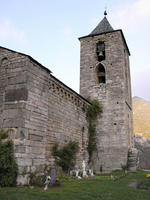You are in: Europe -> Spain -> Catalan Romanesque C... , and traditional search or Image Gallery will yield results of this site only
Catalan Romanesque Churches of the Vall de Boí
| Site number: | 988 |
|
| Type of site: | Cultural | |
| Date: | - | |
| Date of Inscription: | 2000 | |
| Location: | Europe, Spain, Province of Lleida, Autonomous Community of Catalonia | |
Up to 75 images are shown here. Click on each for more details or on Image Gallery for more images.
Six official UN languages:
Arabic,
Chinese,
English,
French,
Russian,
Spanish
Other languages: Catalan, Esperanto, Hungarian, Polish
Other languages: Catalan, Esperanto, Hungarian, Polish
| Description: | Located in the soaring Pyrénées, in the Alta Ribagorça region, the slender Vall de Boí is enclosed by steep mountains. Encircled by a pattern of enfolded fields, each of the valley’s village embraces a Romanesque church. The higher slopes boast widespread seasonally-used grazing lands. --WHMNet paraphrase from the description at WHC Site, where additional information is available. | |
| The Vall de Boí is a narrow, steep-sided valley and a small municipality in the Spanish province of Lleida, in the autonomous community of Catalonia (also known in Spanish as Valle de Bohí). It lies in the northeastern corner of the comarca of Alta Ribagorça, on the edges of the Pyrenees. The valley is best known for its nine Early Romanesque churches, making it the site of the densest concentration of Romanesque architecture in Europe. It was designated as a World Heritage Site by UNESCO on 30 November 2000. Although the valley had a relatively low population in the middle ages, large quantities of silver enriched the local dignitaries to encourage them to join the Catalonian campaign to recover Barbastro and Saragossa. Much of the wealth was spent on the construction of many churches from the 11th to the 14th centuries, in the new architectural style imported from Lombardy. The churches are characterized by elaborate stonework and elegant bell towers. Wall paintings from the churches are conserved at the National Museum of Art of Catalonia in Barcelona. Many of the churches have remained in use for religious worship since they were constructed and consecrated in the 11th and 12th centuries. Nine churches were included in the World Heritage Site: Sant Climent and Santa Maria in Taüll, Sant Feliu in Barruera, Sant Joan in Boí, Santa Eulàlia in Erill la Vall, Santa Maria de l'Assumpció de Cóll, Santa Maria de Cardet, la Nativitat de la Mare de Déu in Durro, and the hermitage of Sant Quirc near Durro. The valley also contains the ruins of a number of other Romanesque religious buildings, including the churches of Sant Llorenç in Saraís and Santa Martí in Taüll, and the hermitages of Sant Cristòfol in Erill, of Sant Quirc in Taüll, of Sant Salvador in Barruera and of Sant Pere in Boí. --Wikipedia. Text is available under the Creative Commons Attribution-ShareAlike License. | ||
| Source: | http://whc.unesco.org/en/list/988 | |
| Reference: | 1. UNESCO World Heritage Center, Site Page. | |














